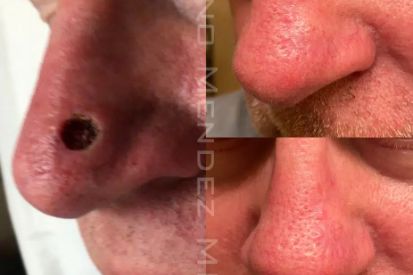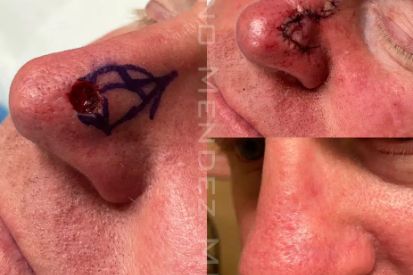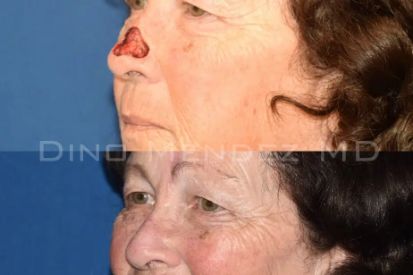Reconstruction After Mohs Surgery
Examples of Reconstruction After Mohs




Warning
This content contains sensitive images.
Reconstruction After Mohs Surgery Explained
Plastic surgery can be used to reconstruct the wound left behind by Mohs surgery. Various techniques can be used depending on the size and location of the defect. Reconstructive surgery provides an ideal surgical result and promotes proper healing. Particularly when performed by a plastic surgeon, whose training is intimately tied to the reconstruction of the head and neck, as well as creating aesthetically pleasing results.
Once your Mohs surgery is complete, the plastic surgeon will examine your defect and discuss the options for healing with you. Several options for reconstruction may be considered including primary closure, rotation of adjacent tissue, or placement of a skin graft taken from another area on the body.
This process aims to achieve the best possible cosmetic and functional results, utilizing various techniques such as sutures, flaps, or grafts. The choice of reconstruction method depends on the size and location of the excised tissue, ensuring not only the elimination of cancer but also the preservation of the skin's appearance and functionality.
Benefits of Reconstruction After Mohs Surgery
- Cosmetic Restoration: The primary benefit involves restoring the natural appearance of the skin, minimizing scarring, and preserving aesthetics.
- Functional Integrity: Reconstruction aims to maintain or restore the functionality of the treated area, ensuring proper mobility and preventing limitations in daily activities.
- Minimized Discomfort: Proper reconstruction contributes to a smoother healing process, reducing discomfort and promoting a more comfortable post-operative experience.
- Enhanced Self-Esteem: Achieving a favorable cosmetic outcome often leads to increased self-confidence and a positive impact on emotional well-being.
- Reduced Recurrence Risk: By ensuring thorough removal of cancerous tissue and effective closure of the surgical site, reconstruction contributes to minimizing the risk of cancer recurrence.
How a Mid TN Skin Dermatologist Can Help?
Reconstruction After Mohs Surgery FAQs
The duration of the reconstruction process varies based on factors such as the size and complexity of the surgical site. Some reconstructions are completed immediately after Mohs surgery, while others may require subsequent appointments. Your surgeon will provide a personalized timeline during the consultation.
While some scarring is inevitable, skilled surgeons aim to minimize its visibility by employing careful techniques. Scars typically fade over time, and post-operative care instructions contribute to optimal healing.
Discomfort during the recovery period is normal, but it is usually manageable with prescribed pain medication. Your surgeon will provide guidance on pain management and ensure your comfort throughout the healing process.
Most patients can resume normal daily activities within a week, but strenuous activities should be avoided for a few weeks. Your surgeon will provide specific guidelines based on your individual case.
Depending on individual circumstances, reconstruction can sometimes be combined with other cosmetic procedures. This decision is made in consultation with your surgeon and is influenced by factors such as overall health and aesthetic goals.
From Our QualDerm Family of Providers: Learn About Reconstruction After MOHS Surgery
What to Expect at Your Reconstruction After Mohs Surgery Appointment
The surgeon will carefully explain the chosen reconstruction technique, address any concerns, and provide information on the expected healing process. Post-operative care instructions, including recovery expectations and follow-up appointments, will be discussed to ensure a successful and comfortable experience throughout the reconstruction journey.
How to Prepare for Reconstruction After Mohs Surgery
Wear comfortable clothing on the day of the procedure, and ensure transportation arrangements, as you may not be able to drive yourself home after receiving any necessary anesthesia. Create a supportive recovery space at home and consider bringing a trusted friend or family member to the appointment to absorb the information provided and offer assistance during the recovery process.
This thoughtful preparation ensures a smooth and well-informed experience as you embark on your reconstruction journey following Mohs surgery.
Planning for Recovery after Reconstruction After Mohs Surgery
· Preventing infection by keeping the incision clean and covered, as instructed by your surgeon
· Avoiding strenuous activity or heavy lifting until healing is complete
· Reducing swelling and bruising
· Avoiding UV radiation
Regular follow-up with your dermatologist is imperative after Mohs surgery.
Featured Products for Sun Safety

EltaMD UV Luminous Broad-Spectrum SPF 41
Get a shade more luminous with our newest lightly tinted sunscreen that brings skin care and essential sun care together. EltaMD UV Luminous Broad-Spectrum SPF 41 uses antioxidants such as linoleic acid and vitamin E to protect your skin from free radicals and diminish UV-related signs of aging. It’s light rosy tint and semi-matte finish blends into the skin seamlessly and blurs imperfections. EltaMD UV Luminous Broad-Spectrum SPF 41 sunscreen is ideal for those seeking non-greasy UV protection with all physical active ingredients. Net wt 1.7 oz/48 g

SkinCeuticals Physical Fusion UV Defense SPF 50
Physical Fusion UV Defense SPF 50 is a tinted, fluid sunscreen that leaves a radiant, even finish. It offers broad spectrum UVA/UVB protection for all skin types, including sensitive, while boosting skin's natural defenses to environmental stress using artemia salina, a plankton extract. This sunscreen is water resistant for up to 40 minutes. 1.7 fl oz / 50 mL
